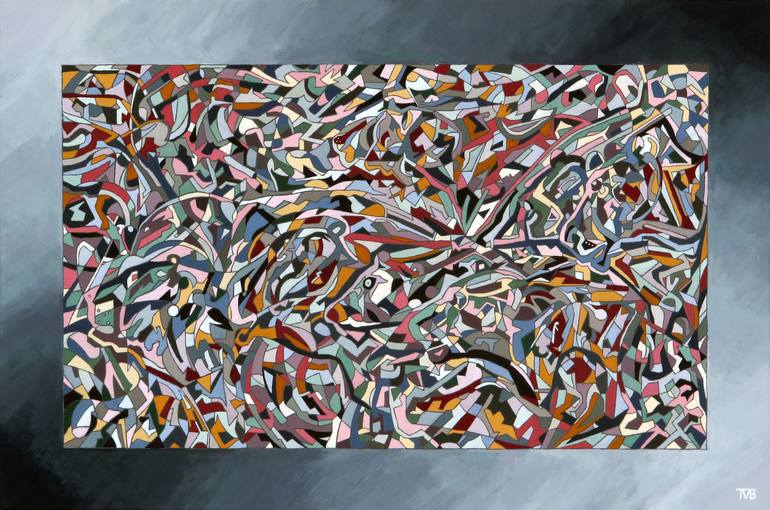


VIEW IN MY ROOM
Tetrac(h)romagnon Painting
United States
Painting, Acrylic on Canvas
Size: 36 W x 24 H x 1.3 D in
About The Artwork
Beginning some 35,000 years ago, Paleolithic Europeans began decorating the walls of a cave in today's southwestern France with artwork on par with some creations that adorn modern-day museums. The images on the walls of the Chauvet cave system—drawings perhaps 20,000 years older than those in Lascaux—shock the viewer with the truth that the cave artists are we, and we are they: there is no division save the superficial. Our intellect and psychology are inescapably congruent across the 900 unknowable generations spanning the interval between those drawings and the first written word. Our human experience is not variable but constant, defined by friendship, ecstasy, frustration, failure, carnal desires, impregnable repulsions, dashed hopes, conquered fears, upward movements damned...all life-dramas made possible by the principal tool that transforms our dreams into realities, the human hand. Since the Chauvet cave was discovered in 1994, the possibility of human tetrachromacy has come to light. In the main, we are trichromats, synthesizing our color experience from retinal cones in groups of three, one cone for each note of an RGB triad, with the possibility of approximately 1 million viewable colors. But a minute percentage of the population is gifted a fourth cone, one that skyrockets the possible perceptible colors to nearly 100 million; this condition is otherwise found only in certain fish, birds, and arthropods. Requiring two X chromosomes in humans, it can only occur in women or in men with Klinefelter syndrome, and the additional cone may not be activated in all those who have the gene. But at least one tetrachromatic woman—an artist, appropriately—has been identified, studied, and publicized widely. But what of the colors of our unknowable past? What of the lives lived in the endless possible chiefdoms, kingdoms, and perhaps vast civilizations that have come and gone before cuneiform impressed our self-knowledge into hubristic relief? And so, a study tetrachromatic is presented to view: red paired with green and orange paired with blue, traveling chromas in complementary hues spanning darkness to light, factoring optics by value.
Details & Dimensions
Painting:Acrylic on Canvas
Original:One-of-a-kind Artwork
Size:36 W x 24 H x 1.3 D in
Frame:Not Framed
Ready to Hang:No
Shipping & Returns
Delivery Time:Typically 5-7 business days for domestic shipments, 10-14 business days for international shipments.
Have additional questions?
Please visit our help section or contact us.
United States
A native of St. Louis who’s lived in middle Tennessee most of his life, Thomas Brodhead studied classical music theory, history, and composition at Oberlin in the 1980s. During those years, he pored over classical scores while studying orchestral and chamber works, unaware that he was absorbing geometric graphic design that’s been in his blood ever since. After college, he worked as a classical sheet music editor and engraver (music typesetter) for 20 years, writing original computer programs to set music notation so that it conformed to the best Greek proportions and geometries. (Importantly, he produced a Critical Performing Edition of the Fourth Symphony of Charles Ives, a work so rhythmically complex that it requires at least two—if not three—conductors to perform.) But arranging black glyphs on white paper grew tiresome, and starting in 2009, he turned to color and began to paint. At first, his paintings were cartoonish and comical, always paired with tongue-in-cheek artist statements on the meaning of each piece. Over time, though, he began to take his work more seriously, exploring color and geometry on large canvases (up to 4 feet by 3 feet), but never failing to pen an accompanying whimsical statement. But more and more the whimsy veiled serious social commentary, often on the dangers of transhumanism (the integration of humans and technology) and the infantilizing effects of social media. Painting and writing thus combined in a Wagnerian Gesamtkunswerk, in which the combination of the two formed the total artwork. He joked that his early humorous style—cartoonish and splattery, with an emphasis on narrative—was “on an overlooked axis connecting Jackson Pollock and Norman Rockwell.” But after studying the color theory of Albert Munsell and discovering the joyous geometries of the artist Stuart Davis, his work took a sharp turn. Still working on larger canvases, he began planning each work in detail, defining the exact composition of its figures and determining its color scheme in advance. The execution of the paintings took longer and longer, one even clocking in at 160 hours. Borrowing a technique from 20th century classical music—and a technique perhaps never before applied to visual art—he produced a series of fractalized paintings that, at times, have a dizzying paint-by-numbers quality.
Thousands Of Five-Star Reviews
We deliver world-class customer service to all of our art buyers.
Global Selection
Explore an unparalleled artwork selection by artists from around the world.
Satisfaction Guaranteed
Our 14-day satisfaction guarantee allows you to buy with confidence.
Support An Artist With Every Purchase
We pay our artists more on every sale than other galleries.
Need More Help?